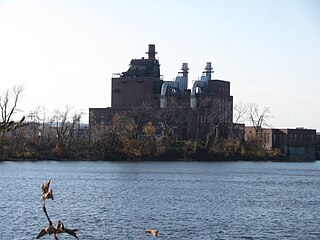
The electric power industry covers the generation, transmission, distribution and sale of electric power to the general public and industry. The commercial distribution of electric power started in 1882 when electricity was produced for electric lighting. In the 1880s and 1890s, growing economic and safety concerns lead to the regulation of the industry. What was once an expensive novelty limited to the most densely populated areas, reliable and economical electric power has become an essential aspect for normal operation of all elements of developed economies.
Eversource Energy is a publicly traded, Fortune 500 energy company headquartered in Hartford, Connecticut, and Boston, Massachusetts, with several regulated subsidiaries offering retail electricity, natural gas service and water service to approximately 4 million customers in Connecticut, Massachusetts, and New Hampshire.

Consolidated Edison, Inc., commonly known as Con Edison or ConEd, is one of the largest investor-owned energy companies in the United States, with approximately $12 billion in annual revenues as of 2017, and over $62 billion in assets. The company provides a wide range of energy-related products and services to its customers through its subsidiaries:

Southern California Edison (SCE), the largest subsidiary of Edison International, is the primary electric utility company for much of Southern California. It provides 15 million people with electricity across a service territory of approximately 50,000 square miles.

The Quebec – New England Transmission is a long-distance high-voltage direct current (HVDC) line between Radisson, Quebec and Westford Road in Ayer, Massachusetts. As of 2012, it remains one of only two Multi-terminal HVDC systems in the world and is "the only multi-terminal bipole HVDC system in the world where three stations are interconnected and operate under a common master control system".

Constellation Energy Corporation is an American energy company headquartered in Baltimore, Maryland. The company provides electric power, natural gas, and energy management services. It has approximately two million customers across the continental United States.

DTE Energy is a Detroit-based diversified energy company involved in the development and management of energy-related businesses and services in the United States and Canada. Its operating units include an electric utility serving 2.2 million customers and a natural gas utility serving 1.3 million customers in Michigan.
National Grid plc is a British multinational electricity and gas utility company headquartered in London, England. Its principal activities are in the United Kingdom, where it owns and operates electricity and natural gas transmission networks, and in the Northeastern United States, where as well as operating transmission networks, the company produces and supplies electricity and gas, providing both to customers in New York and Massachusetts.

The Boston Edison Company (BECo) was incorporated as the Edison Electric Illuminating Company of Boston in 1886. It was one of the earliest electric utility companies in the United States of America. The company was formally renamed the Boston Edison Company in June 1937, although it had also been previously known by this name informally.

Community Choice Aggregation (CCA), also known as Community Choice Energy, municipal aggregation, governmental aggregation, electricity aggregation, and community aggregation, is an alternative to the investor-owned utility energy supply system in which local entities in the United States aggregate the buying power of individual customers within a defined jurisdiction in order to secure alternative energy supply contracts. The CCA chooses the power generation source on behalf of the consumers.

The Town of Wellesley Municipal Light Plant (WMLP) is a town department responsible for the transmission and supply of electricity to the residents and businesses in the town of Wellesley, Massachusetts. The headquarters of the WMLP is located at 455 Worcester Street, Wellesley, Massachusetts, and shares its grounds with the Wellesley Fire Department Headquarters and Town of Wellesley Department of Public Works.

Public Service of New Hampshire, commonly known as PSNH, was the largest public utility in the U.S. state of New Hampshire for decades. Founded in 1926, it sold natural gas and electricity, and for a time ran electric street-railway services and, later, bus service. The company was bought in 1992 and became part of what is now Eversource Energy.

ISO New England Inc. (ISO-NE) is an independent, non-profit regional transmission organization (RTO), headquartered in Holyoke, Massachusetts, serving Connecticut, Maine, Massachusetts, New Hampshire, Rhode Island, and Vermont.
Sawins Pond is a man-made pond created in the 19th century in Watertown, Massachusetts, USA. Its banks were the site of an upscale hotel, and it was a popular fishing and swimming spot. It was then used by Hood Rubber Company, and then BF Goodrich. They deposited scores of barrels onto the site, filled with rubber scraps.

The West Springfield Generating Station, also known by its corporate name EP Energy Massachusetts, LLC, was a fossil-fuel-fired power plant located in West Springfield, Massachusetts. The station was a "peaking" facility, meaning that it primarily operates during peak electrical demand. The facility consisted of two 49-megawatt (MW) combustion turbine generators fueled by natural gas or ultra low-sulphur diesel fuel, one 18 MW jet turbine that was fueled by kerosene, and one 107 MW simple-cycle steam boiler unit burning no. 6 fuel oil, ULSD or natural gas. The station also had a small auxiliary boiler for process and building heat and an emergency back-up generator.
Vermont electric power needs are served by over twenty utilities. The largest is Green Mountain Power, a subsidiary of Énergir which recently also took over Central Vermont Public Service. Together this single company represents 70% of the retail customers in Vermont. The state is a small electricity consumer compared with other states. Therefore, its electricity sector has the lowest carbon footprint in the country. As of 2010, the state had the lowest wholesale electricity costs in New England. Efficiency Vermont engages in aggressive initiatives to cut residential electricity waste, which often identifies other problems that it claims can save hundreds per household per year. Accordingly, Vermont's overall energy bills are also relatively lower than in the rest of the New England states.
Unitil Corporation is an interstate electricity and natural gas utility company that provides services for New Hampshire, Massachusetts and Maine. Its earliest predecessor company, the Portland Gas Light Company, was founded in Maine in 1849. The current company was set up in 1984 and is based in New Hampshire. With a market cap of 686.51M, it provides electric services to about 102,400 customers and natural gas to over 75,900 customers. The service territory of Unitil includes business districts and recreational centers as well as commercial and industrial business, such as electronic component manufacturers and education institutes. The company has an enterprise value of $766.54 million. The non-utility business is operated through the company's subsidiary, U-source, which is a national energy brokering and consulting company.

Anbaric Development Partners (Anbaric) is an American electric power transmission and storage development company located in Wakefield, Massachusetts. The company develops smart grid, renewable energy, and large-scale electric transmission projects which use high-voltage direct current (HVDC) technology for clients in the United States and internationally.













